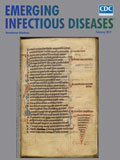
Volume 25, Number 2—February 2019
Letter
Mycobacterium lepromatosis Lepromatous Leprosy in US Citizen Who Traveled to Disease-Endemic Areas
On This Page
To the Editor: Virk et al. (1) reported a Mycobacterium lepromatosis infection in a US citizen with a history of multiple international travels and concluded that M. lepromatosis lepromatous leprosy is a travel-related hazard for travelers to endemic areas. The conclusions drawn, however, need extensive support of thoroughly conducted case studies before generalizing M. lepromatosis as a travel-related hazard.
In the case report, the exact source of M. lepromatosis infection was unclear. Moreover, experimental evidence used in this work are not enough to prove that M. lepromatosis is a travel-related hazard. Confirming a source of infection by DNA fingerprinting of M. lepromatosis can be ideal to rule out infection from unreported native patients or environmental reservoirs (2).
It is possible that the patient in this report may have contracted M. lepromatosis infection as a result of his host-susceptible genetic factors. Host genetic susceptibility to leprosy is complicated because of the genetics of M. lepromatosis, interaction between genetic and environmental factors, gene–gene interactions, and ethnicity (3). Host genetics plays a major role in determining a person’s risk of developing clinical leprosy. Thus, even a short trip to a leprosy-endemic country is sufficient for a host susceptible to M. lepromatosis to acquire an infection. The host immune response influences the course of leprosy infection; it is challenging to understand the genetics of disease susceptibility and immunopathogenesis of leprosy (4,5).
With an inference of only a single case study, it is hard to say that M. lepromatosis lepromatous leprosy is a travel-related hazard for all US citizens. More surveillance data, such as patients’ immunity toward the disease, their genetic susceptibility, and travel history, are needed to explore the travel-related hazard. In addition, evolutionary knowledge and how widely the disease is circulating in nonendemic regions will help in understanding the nature of the disease.
References
Original Publication Date: 1/7/2019






















.png)











No hay comentarios:
Publicar un comentario